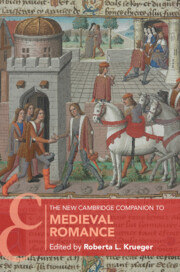Book contents
- The New Cambridge Companion to Medieval Romance
- The New Cambridge Companion to Medieval Romance
- Copyright page
- Contents
- Figures
- Contributors
- Acknowledgments
- Chronology
- Introduction
- 1 “For Love and For Lovers”
- 2 The Manuscript Contexts of Medieval Romance
- 3 Matters of Form
- 4 Authors, Narrators, and Their Stories in Old French Romance
- 5 Arthurian Transformations
- 6 Romance and the Medieval Mediterranean
- 7 The Crusading Romance in Britain
- 8 “Making Race” in Medieval Romance
- 9 The Construction and Interrogation of Gender in Old French Romance
- 10 Emotions as the Language of Romance
- 11 Medieval Iberian Romance
- 12 Medieval and Early Modern Italian Romance
- 13 German Medieval Romance
- 14 The Ends of Romance in Chaucer and Malory
- 15 French Romance in the Late Middle Ages and the Renaissance
- 16 Romance in Historical Context
- 17 Romance in Twentieth- and Twenty-First-Century Popular Culture
- Bibliography of Editions and Translations
- Index
- Cambridge Companions To …
- References
16 - Romance in Historical Context
Literature and the Changing Values and Norms of Aristocratic Society
Published online by Cambridge University Press: 11 May 2023
- The New Cambridge Companion to Medieval Romance
- The New Cambridge Companion to Medieval Romance
- Copyright page
- Contents
- Figures
- Contributors
- Acknowledgments
- Chronology
- Introduction
- 1 “For Love and For Lovers”
- 2 The Manuscript Contexts of Medieval Romance
- 3 Matters of Form
- 4 Authors, Narrators, and Their Stories in Old French Romance
- 5 Arthurian Transformations
- 6 Romance and the Medieval Mediterranean
- 7 The Crusading Romance in Britain
- 8 “Making Race” in Medieval Romance
- 9 The Construction and Interrogation of Gender in Old French Romance
- 10 Emotions as the Language of Romance
- 11 Medieval Iberian Romance
- 12 Medieval and Early Modern Italian Romance
- 13 German Medieval Romance
- 14 The Ends of Romance in Chaucer and Malory
- 15 French Romance in the Late Middle Ages and the Renaissance
- 16 Romance in Historical Context
- 17 Romance in Twentieth- and Twenty-First-Century Popular Culture
- Bibliography of Editions and Translations
- Index
- Cambridge Companions To …
- References
Summary
It is difficult to reconstruct and analyze the relationship between romances and their historical contexts, especially because of the power of modern myths about chivalry. There was no single age of chivalry that stretched from the eleventh or twelfth centuries to the fifteenth century and beyond, and there was no single code or ideal for how aristocrats should behave during that period. Societies and cultures inevitably changed over time, and there were important geographical variations across the different regions, lands, and linguistic contexts that today form Western Europe. Therefore, medieval romances must be considered against the specific historical contexts in which they were produced and read. This chapter focuses on examples and case studies drawn from fourteenth- and fifteenth-century France and England, a period that has often been dismissed as one of chivalric decline. Yet radical changes in warfare, aristocratic class, and identity, as well as lay literacy and engagement with book ownership and writing created a dynamic context for the production and consumption of chivalric texts of all kinds.
Keywords
- Type
- Chapter
- Information
- The New Cambridge Companion to Medieval Romance , pp. 243 - 256Publisher: Cambridge University PressPrint publication year: 2023

